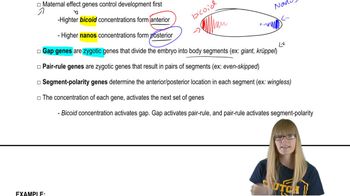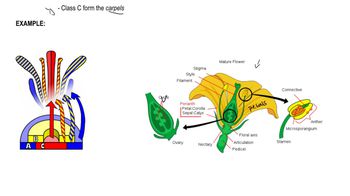Table of contents
- 1. Introduction to Genetics51m
- 2. Mendel's Laws of Inheritance3h 37m
- 3. Extensions to Mendelian Inheritance2h 41m
- 4. Genetic Mapping and Linkage2h 28m
- 5. Genetics of Bacteria and Viruses1h 21m
- 6. Chromosomal Variation1h 48m
- 7. DNA and Chromosome Structure56m
- 8. DNA Replication1h 10m
- 9. Mitosis and Meiosis1h 34m
- 10. Transcription1h 0m
- 11. Translation58m
- 12. Gene Regulation in Prokaryotes1h 19m
- 13. Gene Regulation in Eukaryotes44m
- 14. Genetic Control of Development44m
- 15. Genomes and Genomics1h 50m
- 16. Transposable Elements47m
- 17. Mutation, Repair, and Recombination1h 6m
- 18. Molecular Genetic Tools19m
- 19. Cancer Genetics29m
- 20. Quantitative Genetics1h 26m
- 21. Population Genetics50m
- 22. Evolutionary Genetics29m
14. Genetic Control of Development
Developmental Patterning Genes
Problem 24b
Textbook Question
Homeotic genes are thought to regulate each other. What aspect of the phenotype of apetala2 agamous double mutants indicates that these two genes act antagonistically?
 Verified step by step guidance
Verified step by step guidance1
Understand the role of homeotic genes: Homeotic genes are responsible for determining the identity of particular segments or structures in an organism. In plants, these genes help define the identity of floral organs.
Identify the function of APETALA2 and AGAMOUS: APETALA2 (AP2) is involved in the development of sepals and petals, while AGAMOUS (AG) is crucial for the development of stamens and carpels.
Explore the concept of antagonistic interaction: When two genes act antagonistically, they have opposing effects on a particular trait or phenotype. This means that the activity of one gene can suppress or counteract the activity of the other.
Analyze the phenotype of apetala2 agamous double mutants: In these mutants, observe the floral organ identity and arrangement. The double mutant phenotype can reveal how the loss of both genes affects the development of floral organs.
Determine the antagonistic relationship: If the double mutant phenotype shows a balance or intermediate state between the phenotypes of the single mutants, it suggests that APETALA2 and AGAMOUS act antagonistically to regulate floral organ identity.
Recommended similar problem, with video answer:
 Verified Solution
Verified SolutionThis video solution was recommended by our tutors as helpful for the problem above
Video duration:
3mPlay a video:
Was this helpful?
Key Concepts
Here are the essential concepts you must grasp in order to answer the question correctly.
Homeotic Genes
Homeotic genes are a group of regulatory genes that control the development of anatomical structures in various organisms. They play a crucial role in determining the identity of body parts during embryonic development. In plants, these genes can influence flower morphology, leading to specific arrangements of floral organs.
Recommended video:
Guided course

Segmentation Genes
Antagonistic Gene Interaction
Antagonistic gene interaction occurs when two genes exert opposing effects on a particular trait or phenotype. In the context of the apetala2 and agamous genes, this means that the presence of one gene can suppress or negate the effects of the other, leading to distinct phenotypic outcomes when both are mutated.
Recommended video:
Guided course

Interacting Genes Overview
Phenotypic Analysis
Phenotypic analysis involves studying the observable characteristics or traits of an organism resulting from the interaction of its genotype with the environment. In the case of apetala2 agamous double mutants, examining the resulting flower structure can reveal how these genes interact and provide insights into their functional roles in floral development.
Recommended video:
Guided course

Chi Square Analysis

 11:19m
11:19mWatch next
Master Segmentation Genes with a bite sized video explanation from Kylia Goodner
Start learningRelated Videos
Related Practice


